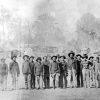calsfoundation@cals.org
Elkanah Greer (1825–1877)
A native Tennessean, Elkanah Brackin Greer served in the Confederate army during the Civil War. He rose to the rank of brigadier general, with much of his service spent in Arkansas.
Born on October 11, 1825, in Paris, Tennessee, Elkanah Greer was the son of James Madison Greer and Rachel Brackin Greer. His father was the son of an officer who served in the American Revolution and worked as a farmer. In the 1850 federal census, the family lived in Marshall County, Mississippi, and owned about $800 of property. During the Mexican War, Greer served as a private in the First Mississippi Rifles, under the command of Colonel Jefferson Davis.
Greer moved between Mississippi, Texas, and Tennessee in the 1850s, marrying Anna Holcomb in Tennessee in 1851. The couple would have four children. Living in Marshall, Texas, Greer became involved in a number of businesses, including a law practice and a railroad.
Deeply involved in politics, Greer supported the expansion of slavery and owned a dozen enslaved people in 1860. He became an officer in the Knights of the Golden Circle organization, created to expand American based slavery into Mexico, Central America, Cuba, and throughout the southern portion of North America. The organization created military units to support this expansion, and Greer raised a regiment of cavalry in 1860 to lead an invasion of Mexico to put the plan in motion. Texas governor Sam Houston declined the offer.
Serving as a delegate to the 1860 Democratic Convention, Greer returned to Texas and joined calls for secession upon the election of Abraham Lincoln. He organized the Third Texas Cavalry in May and June 1861, serving as colonel of the unit. The regiment moved through Arkansas to Missouri, where the men fought at the Battle of Wilson’s Creek on August 10, 1861. The 800-strong regiment lost four killed and twenty-three wounded. In December, the regiment participated in the Battle of Chustenahlah in the Indian Territory.
Joining a cavalry brigade under the command of Brigadier General James McIntosh, Greer and his men fought at the Battle of Pea Ridge in March 1862. In the confusion following the deaths of both McIntosh and Brigadier General Benjamin McCulloch, as the senior officer on the field, Greer took command of remnants of a division containing almost all the Confederate troops participating in the battle. After the battle, Greer received command of a cavalry brigade in the newly reorganized army under Major General Earl Van Dorn.
Marching across the state, the regiment was dismounted at DeValls Bluff (Prairie County), and their horses were reportedly sent back to Texas. Moving east across the Mississippi River, the regiment joined Confederate forces in northern Mississippi. Greer was wounded at Pea Ridge and resigned from the army in June 1862, returning to Texas.
This did not stop his service, as he received an appointment as a brigadier general in the Confederate army on October 8, 1862. In May 1863, Greer received orders to report to the headquarters of the Confederate Department of the Trans-Mississippi in Shreveport, Louisiana. The following month, he took command of the conscript department with a post in Marshall, Texas, with responsibility for gathering recruits and draftees. Greer made progress in improving the department, receiving praise in an inspector general’s report in February 1864 for his efforts. In addition to this role, Greer also commanded reserve troops in Texas.
During the 1864 Red River Campaign and Camden Expedition, Greer organized troops for service in the field. He also received orders to prepare to defend Shreveport or Marshall, but the Union advance never threatened either location. Additional orders for Greer to send Texas militia into Arkansas to guard Fulton (Hempstead County) were issued but never carried out.
Later that year, Greer placed reserve troops in the field during Sterling Price’s raid into Missouri and worked to provide troops for frontier defense in Texas. He faced difficulties with frontier defense, as Texas state authorities also wanted to exercise military control over the area against Native Americans. Greer also led efforts to gather enslaved people for forced labor on Confederate military projects in the department.
On March 27, 1865, Greer received orders relieving him of command of the conscription bureau, and he took command of the Reserve Corps of the state of Texas. Greer concluded his military service in that post.
Greer resigned his commission in May 1865 and returned to civilian life. He worked in various businesses and died on March 25, 1877, in DeValls Bluff while visiting his sister. He is buried in Elmwood Cemetery in Memphis, Tennessee. Anna Greer died in 1887 and is buried in Marshall.
For additional information:
Barron, S. B. The Lone Star Defenders; A Chronicle of the Third Texas Cavalry, Ross Brigade. New York: Neale Publishing Company, 1908.
Dunn, Roy Sylvan. “The KGC in Texas, 1860–1861.” Southwestern Historical Quarterly 70, no. 4 (1967): 543–573.
Hale, Douglas. “The Third Texas Cavalry: A Socioeconomic Profile of a Confederate Regiment.” Military History of the Southwest 19 (Spring 1989): 1–26.
Shea, William L., and Earl J. Hess. Pea Ridge: Civil War Campaign in the West. Chapel Hill: University of North Carolina Press, 1992.
Warner, Ezra. Generals in Gray: Lives of Confederate Commanders. Baton Rouge: Louisiana State University Press, 1959.
David Sesser
Southeastern Louisiana University
 Civil War through Reconstruction, 1861 through 1874
Civil War through Reconstruction, 1861 through 1874 Military
Military



Comments
No comments on this entry yet.